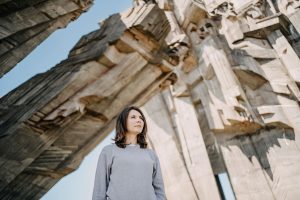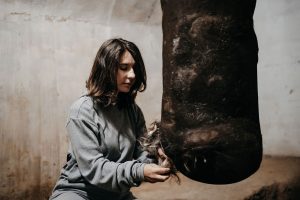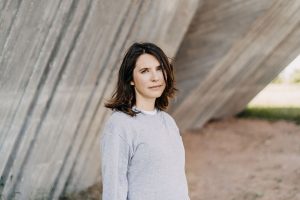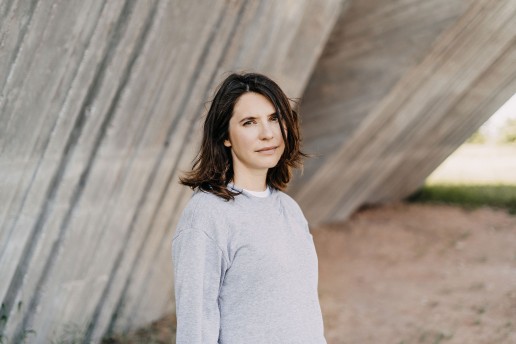MoFu artist K.Pisarikova interprets Kaunas 9th fort
 „That suffering or what was happening in the 9th fort is indescribable and incomprehensible. I am thankful for the opportunity to live in peace and freedom” – says Karin Pisarikova, the artist from Brno, Czech Republic.
„That suffering or what was happening in the 9th fort is indescribable and incomprehensible. I am thankful for the opportunity to live in peace and freedom” – says Karin Pisarikova, the artist from Brno, Czech Republic.
K.Pisarikova – one of the artists participating in „Kaunas – European Capital of Culture 2022“ project, that is partly funded by „Creative Europe'' – „Modernism for the future 365/360“ (MoFu). These are art interpretations on modernism architecture. Various artists together with local researchers and heritage community will create 17 art projects in the 20th century modernism buildings. Six of them are located in Kaunas.
“The Idea of “Come in the form of milk” (“Atplauk pieno puta”) project – to interpret and present the memorial of Kaunas 9th fort in the form of visual language using not logical but emotional associations. To capture genius loci and to remind of human resilience: psychological, emotional, physical and social.
Project iconology was directly selected from the highest memorial part “Liberation” (“Išsilaisvinimas”), that depicts powerful figures, emerging and freeing themselves from violence, terror, oppression. An important part of iconology is clenched fists crowning the composition. That is why I focused on this unique gesture and developed it further.” – says the artist.
K.Pisarikova – artist, curator and associate lecturer born in Brno city, Czech Republic. The biggest inspiration for her creation comes from life: human connections and daily rituals.
Karin usually creates art installations, has experience in performance, visual art and photography fields. Typical material for an author's work is human hair. Such a choice is determined by hair ambiguity, connection with the body. Main artist’s topics are: human’s life, creative process in everyday life, authenticity, fiction and reality.
That is why human hair used for the project wasn’t new or an accidental element. K. Pisarikova has been using this material in her creations for a long time: for its meaning - positive or negative connotation and for its direct connection with the human body, connection with ancestors, and finally - for its infinite cycle of growth.
The costumes of the creative group represent the people from the whole world who are united by the uniforms - sportswear, grey colour - they merge with the concrete shades of Kaunas 9th fort memorial.
Artist’s children who worked together on this project, symbolize hope and being “here and now“. Children who don’t belong to anyone, who appear and disappear, who can be a gift and at the same time a doom for a planet. However, they symbolize human resilience, ability to rise and look forward, no matter all the bad things that had happened in the past.

– Why are you participating in the “MoFu” project? What is interesting to you about it?
– I grew up in a modernist house built in the 30s. It was my family home from when I was three. That's why I thought it's perfect because I have done projects around home and I feel connected to it.
Since I got children I started thinking about the first home. First home is inside the mother and after birth we change home. What is home for us? It’s an extension of our body or a shelter for it. This concept was interesting, so I was hoping to work with modernism architecture. What is more, my father is an architect. He is connected to brutalist architecture.
At first I was worried about the pandemic, so I applied for a project in Brno but I was chosen to participate in Kaunas. I was excited - I love visiting various places. In my work and in my life I love coincidences. Sometimes you meet someone and I think this is a very nice coincidence.
– You create interpretations for Kaunas 9th fort. What was the first impression of this object after “meeting” it?
– I think it's a dark place with a lot of heavy energy. When I visited it for the first time, it was shocking. I think it is hard to even touch the subject. I think that suffering or what was happening in the fort is indescribable, incomprehensible for us or just for me because I have not had any hurdles like that in my life.
In the fort you are thinking about the memorial in a respectful way without going too much into the concrete details of what used to be happening there.
– Can you elaborate about your idea for interpretation underline fort and what is the form of your creation here in Kaunas?
– I focused on the memorial monument after the ninth fort. It’s a brutalist monument. Regarding the message I was very interested in how it’s phases changed through the time.
I was looking at the final form and what message this sculptor wanted to convey as much as the permanent aspect of the monument. Suffering and hope can be seen. There are three parts and the final one - victory - that was the most noticeable. It's a bit controversial but it's like a strong visual signal for me.

– Your inspiration comes from life: human connections, daily rituals. For your creations the common material is human hair. How did human hair become like an instrument for your creation?
– I believe each of us has something in their life that you are drawn to and you don't know why. For me it has always been hair. Since I was little I have really liked hair or this kind of material.
I work as a hairdresser as a part time job. But I really started using hair after moving to Japan (in 2015 the artist completed her PhD. at Tama Art University, Tokyo – author’s note). This was something I already knew and I could relate to even in a foreign country. I could not speak the language and I was really lost. However, there was a hairdresser’s next to the place I lived and I could smell the familiar smell of wet hair. You know, it has a certain smell.
Then I slowly started to make a connection with the people by going there and asking them for the material for my works.
Also in Japan (I guess in many cultures, but in Japan particularly) the hair is connected to life. There's a parallel between. Long, black, thick hair symbolizes energy. So if you start going gray or lose hair it means you're losing energy. That's why so many Japanese men color their hair, because showing that you have gray hair is a sign that you cannot work anymore. Hair has a super power. For me it’s the energy.
I started doing some sculptures and installations from the hair. I made a jellyfish out of hair. Hair contains both life and death. It is beautiful when it's attached to your head and it's part of it. But once it's cut, it's something disgusting, it becomes an object. In a matter of a split of a second - it changes from beautiful to ugly.
– What connection have you created with Kaunas and its history?
– We had a guided tour around Kaunas modernism architecture objects. I love it, I think it's beautiful. The monuments are also impressive and memorable. What connection have I created? There's this connection between Brno and Kaunas - they are the partner cities, and also they have a similar history of modernism.
From 1930 to 1995 there was a big wave of modernism architecture. Just like you, we also had a big Jewish community, so there’s a lot of their cultural legacy and UNESCO monuments. So, in Kaunas this kind of similarity feels like home now. But I enjoy the differences as well.
– Can your project become a bridge between these two cities and deepen the awareness of 20th architecture and its stories?
– Yes, that would be nice. I always think about connecting cultures or how to learn more about them. It's super useful and super important to me because it basically lets you learn about yourself. You look at your beliefs and find out about yourself. Traveling in different cultures, you can travel inside your soul.
– A month in Lithuania, creating and traveling with your family. What is your family connection with your creation, what is their role?
– They are part of me. This is a long story. We have this movement in Check that is called “Mothers art lovers”. It's a group of artists who are mothers and we were trying to discuss the possibility of working because it's not easy. For instance, I have been to some artists' residencies, but usually they don't accept families. It's just the artist, but if you have small children you can’t really leave them alone at home. Since my husband is working, I can’t leave a 2 year old. But I also want to work, because I would have more than a 10 year gap if I did not. I don't want to wait, so I try to include my family and work with them. This is how I developed some of the projects. Of course, when I can, I also do something on my own. But sometimes I need a longer period of time because for me it's important to see what Kaunas is about. I didn’t want to come and shoot a few photos and just leave. I really wanted to see the atmosphere, so I had to include my family. Sometimes they become an inspiration. I always tell them about the place, and they are interested to know what happened there. They were reading the stories to see the world the other children went through.
– What are the key values you share in your art and how do they help expressing your idea?
– I want to step back and talk generally about humanity and human experience. The most attention is for values like hope, resilience and survival. I like mythology a lot, so I think I use it to express them. It (mythology) tells us a lot. So I used it for the work I did.
Hero’s journey, as the hero starts and goes. He encounters challenges, and comes to the lowest point. There is a fight which can be internal or external. Now the hero's journey can be applied also to your internal struggles. So the hero sets off into the unknown and then there are some struggles, challenges and temptations. There's death and rebirth.
[embedyt] https://www.youtube.com/watch?v=n8EiRYW9OV8[/embedyt]
Photos by M. Plepys
Text authors: journalist of „15min“ Jurgita Lieponė and Sandra Karnilavičiūtė. Text in lithuanian can be found here 15min.lt.


